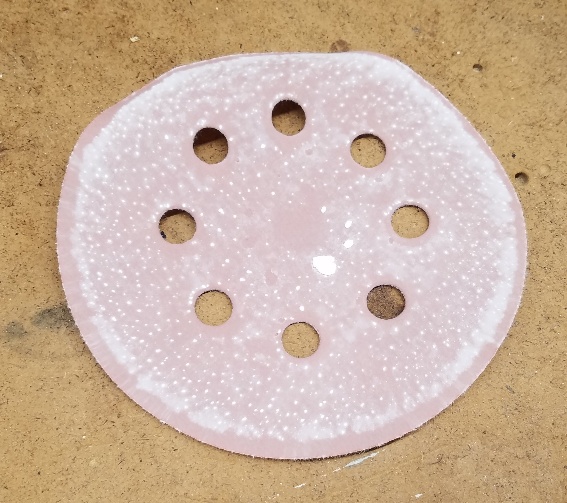Posts: 1,618
Threads: 0
Joined: Feb 2010
Location: Coast of Maine
Working on sort of a river coffee table, entire top is clearcoated with epoxy which I want to polish to a mirror finish. I've done a fair amount of epoxy work but have never sanded beyond 220 grit nor have I ever polished a surface. Used Total Boat 2:1 epoxy as I've done in the past with no issues with curing. Previous coats of epoxy were cured then ros sanded to 220 before clearcoat. Total Boat says 4-5 days to cure, has sat for 10 days at about 70 degrees and is hard as a rock. Sanded with 400 abranet to flatten and noticed a little loading near the center of the disc. Switched to a paper 600 grit disc and after a short time sanding it looks like this.
Switched to a 1000 grit paper, after less than 30 seconds it started to load. I'm using a Bosch 5"ROS connected to a DeWalt HEPA vac with a dust deputy. There's plenty of suction, little if any dust is evident on or around the work piece.
Any ideas as to how to keep the paper from loading up?
Thanks for reading, g
I've only had one...in dog beers.
"You can see the stars and still not see the light"
The Eagles: Already Gone
Posts: 1,605
Threads: 0
Joined: Jan 2014
not positive, but have you tried wet sanding?
Posts: 1,618
Threads: 0
Joined: Feb 2010
Location: Coast of Maine
Thanks Brian but that's just not an option for this piece. I've watched a number of folks on uTube sand river tables, they don't seem to have this issue nor can I find anyone that addresses it.
Also, I've tried cleaning the paper with an eraser stick but the stuff doesn't come off.
Thanks, g
I've only had one...in dog beers.
"You can see the stars and still not see the light"
The Eagles: Already Gone
Posts: 7,421
Threads: 1
Joined: Sep 2005
07-01-2020, 11:30 AM
(This post was last modified: 07-01-2020, 11:30 AM by Cooler.)
When some of the newer types of sandpaper get clogged, I find that I can wash that out with a strong stream of water and a stiff nylon brush. I do this over and over until the grit gets dull.
I've been mostly using their block sanders, but they also make disks. I found that if it is hook and look it is fine to get it wet. I don't know if the epoxy will wash out though. Give it a try.
Allow it to thoroughly dry before reusing.
Also gauge the sharpness of the grit by running your finger over it. It should "grab" your skin. When you can easily slide your finger over the surface the grit is getting dull. It will still cut, but you will end up working harder than necessary.
This is the sander I use:
![[Image: 41sWJByit8L._AC_SY355_.jpg]](https://images-na.ssl-images-amazon.com/images/I/41sWJByit8L._AC_SY355_.jpg)
When I run out of my current inventory on discs I will try the Gator ones too.
No animals were injured or killed in the production of this post.
Posts: 1,605
Threads: 0
Joined: Jan 2014
I have sanded to about 1200 using wet technique on my sculling boats and kayaks (both are epoxy/fiberglass)...
Maybe a change of paper will help resolve the issue...
Good luck
Posts: 1,618
Threads: 0
Joined: Feb 2010
Location: Coast of Maine
I bought Sungold ROS discs on the recommendation of a utube epoxy table builder. I went to Amazon & read reviews and a number of people have the same issue with loading. I think I'll forge ahead and change out a lot of sanding discs. Will take some time to get this table top sanded to 2000 grit.
Thanks guys, g
I've only had one...in dog beers.
"You can see the stars and still not see the light"
The Eagles: Already Gone
Posts: 262
Threads: 0
Joined: Jan 2020
Another vote for wet sanding. Wet sanding in woodworking is not like wet sanding in auto body work. I use a spray bottle of mineral spirits that dries faster than I would like so, no runs, no mess. Wipe often with paper towels and toss them frequently into a bucket of water. Sanding with a ROS for polishing is after you have achieved a smooth flat surface. Although people do it, sanding large flat surfaces with low grits and a ROS will give your table a river effect that is not the one you are after ;-)
When I was young I sought the wisdom of the ages. Now it seems I've found the wiz-dumb of the age-ed.
Posts: 251
Threads: 0
Joined: Sep 2004
If you have an air sander, try slowing it down. High speed creates heat which softens plastics and old finishes. Working on auto paint/body that is often an issue, especially with old lacquer or single part enamels . I guess one could slow an electric with a router speed control accessory, but would lose power also.
That said, wet is the best answer if possible. Maybe spray the paper before starting and often, rather than applying it to the work.
Posts: 10,736
Threads: 1
Joined: Jan 2006
Location: Orlando, Florida
Your best friend will be wet sanding. As you've discovered, the paper will load up quickly. It doesn't take much heat to dissolve the epoxy which then loads up the paper. It'll still load up, but not nearly as fast as you're experiencing.
Still Learning,
Allan Hill
Posts: 3,545
Threads: 1
Joined: May 2004
Location: Wisconsin
Since the problem gets worse as the grit gets finer, it sounds consistent with friction-caused heat. The vacuum is increasing friction by pulling the sander down to the surface, though it is also helping to get dust out of the way. If wet sanding is impractical, try less suction, perhaps by an incomplete seal of the hose to see if that helps.







![[Image: 41sWJByit8L._AC_SY355_.jpg]](https://images-na.ssl-images-amazon.com/images/I/41sWJByit8L._AC_SY355_.jpg)